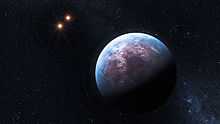Gliese 667 Cb
| Extrasolar planet | List of extrasolar planets | |
|---|---|---|
| Parent star | ||
| Star | Gliese 667C | |
| Constellation | Scorpius | |
| Right ascension | (α) | 17h 18m 57.16483s |
| Declination | (δ) | −34° 59′ 23.1416″ |
| Apparent magnitude | (mV) | 11.03 |
| Mass | (m) | 0.31 M☉ |
| Radius | (r) | 0.42 R☉ |
| Temperature | (T) | 3700 K |
| Metallicity | [Fe/H] | −0.59±0.10 |
| Age | 2–10 Gyr | |
| Physical characteristics | ||
| Mass | (m) | 5.94–~12 M⊕ |
| Stellar flux | (F⊙) | 5.5 ⊕ |
| Temperature | (T) | 473 |
| Orbital elements | ||
| Semimajor axis | (a) | 0.050432±0.000001 AU |
| Eccentricity | (e) | 0.112 |
| Orbital period | (P) | 7.2006 d |
| Inclination | (i) | >30° |
| Semi-amplitude | (K) | 3.8 m/s |
| Discovery information | ||
| Discovery date | 2009 | |
| Discoverer(s) | ||
| Discovery method | Radial velocity (European Southern Observatory) | |
| Discovery status | Confirmed | |

Artist's impression of Gliese 667 Cb with the Gliese 667 A/B binary in the background.
Gliese 667 Cb is an exoplanet orbiting the star Gliese 667 C, a member of the Gliese 667 triple-star system. It is the most massive planet discovered in the system and is likely a super-Earth or a mini-Neptune. Orbital-stability analysis indicates that it cannot be more than twice its minimum mass. It orbits too close to the star to be in the habitable zone.[1] Eccentricity analysis indicates that Gliese 667 Cb is not a rocky planet.[2]
References
- ↑ Anglada-Escudé, Guillem et al. (2013-06-07). "A dynamically-packed planetary system around GJ 667C with three super-Earths in its habitable zone" (PDF). Astronomy & Astrophysics. arXiv:1306.6074. Bibcode:2013A&A...556A.126A. doi:10.1051/0004-6361/201321331. Retrieved 2013-06-25.
- ↑ The high multiplicity systems Gliese 667C and KOI 3158 Second Kepler Science Conference, 5th November 2013
| ||||||||||
| ||||||||||||||||||||||||||||||||||||||||||||||||||||||||||
| ||||||||||||||||||||||||||||||||||||||||||||||||||||||||